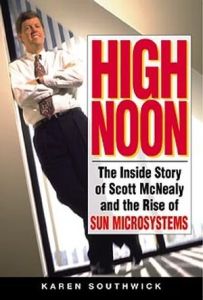Join getAbstract to access the summary!

Join getAbstract to access the summary!
Karen Southwick
High Noon
The Inside Story of Scott McNealy and the Rise of Sun Microsystems
Wiley, 1999
What's inside?
A cautionary tale to start-ups: Sun Microsystem boomed only after its founder was replaced as CEO by the now ubiquitous Scott McNealy.
Recommendation
Author Karen Southwick reveals how a few kids from Stanford University turned Sun Microsystems into a $10 billion industry powerhouse. This incredibly detailed book revisits many of the key moments in Sun’s history, leading up to the recent excitement over the Java programming language. The author shows how Scott McNealy’s unique personal style played an instrumental part in Sun’s direction. Despite McNealy’s prominence in the book, this is really a saga about Sun Microsystems and the technology economy. While she makes some effort to provide McNealy’s biography, the author is clearly more interested in the strategic corporate moves Sun made to position itself for the future. getAbstract recommends this book as essential reading for anyone in the early stages of a technology start-up, and fascinating reading for anyone even slightly interested in business.
Summary
About the Author
Karen Southwick is a managing editor at Forbes ASAP She is the author of Silicon Gold Rush.



















Comment on this summary